Game design
Quando se trata de como os MMO's têm sido projetados tradicionalmente, a maioria dos jogadores está familiarizada com dois tipos distintos de loops de jogo: o "Theme park", e o "Sandbox". A grande maioria dos MMO's que todos vimos entrar e sair na indústria de jogos tem sido da variedade de theme parks - estes jogos colocam o jogador em um caminho específico, guiando-o, com muitas vistas bonitas entre os mesmos velhos quest hubs, muito pouco em caminhos divergentes, praticamente sem liberdade na progressão do jogador. Recentemente o gênero MMO tem visto alguns jogos da natureza sandbox entrarem em cena, mas apesar da liberdade final que a sandbox proporciona aos jogadores, muitos ficam querendo mais, pois não há por definição nenhum conteúdo mundial pré-construído, nenhum toque humano, apenas a vastidão da "areia" (sandbox) por falta de um termo melhor. Assim, muitos jogadores de MMO muitas vezes se encontram presos entre a rocha repetitiva do theme park ou os vastos espaços mortos do lugar duro do sandbox. Este abismo entre o estado dos loops de jogo MMO é onde pretendemos injetar o sistema de Nodes do Ashes of Creation.[1]
Para que a mecânica do sandbox tenha algum significado, deve haver um conteúdo curado para acompanhar as escolhas do jogador. O que significa que, como desenvolvedores, devemos criar esse conteúdo no estilo themebox, mas para cada caminho possível que a comunidade possa tomar.[2] – Steven Sharif
O design de Ashes of Creation adere a cinco Pilares de Design.[3]
Ao projetar o Ashes of Creation, nós aderimos cada detalhe a cinco pilares principais: História Imersiva, um Mundo Reativo, Interação entre Jogadores, Agência do Jogador, e Risco vs Recompensa. Mesmo no ambiente, tudo o que você, como jogador, faz, vai amarrar a estes pilares, enquanto tudo o que sua guilda faz, tudo o que seu servidor faz, no final das contas, vai manter o mundo fresco, sempre em mudança e, o mais importante... excitante.[3]
Inspiration from other titles
Ashes of Creation has taken inspiration from various other MMORPG titles.[4]
- In terms of what came before, we're trying to figure out who did what best and take inspiration from that: Move the genre forward; keep things updated and bring it into the 21st century.[4] – Jeffrey Bard
- Eve Online with its regionalized economy and risk vs reward in transportation.[4]
- ArcheAge with its building systems, transportation and naval combat.[4]
- Star Wars Galaxies with its crafting systems.[4]
- Lineage II with its risk vs reward, castle sieges, flagging, open world PvP and guild progression.[5][6][7][4]
- A lot of the systems in Lineage 2 were based around a concept that got lost today in mmorpgs, and that's risk versus reward. You know this idea that the more you risk the greater potential reward should be present is a complete paradigm shift away from everyone's a winner, everybody gets a participation reward, and here you go, congratulations you're a player in this game; and that's boring. It gives nothing for a person to aspire to achieve something, or to feel the bite of loss when you fail. Those are the driving forces of why people want to play games and it's a reason why new games when they come out have such a short lifespan, because they are always competing with WOW. You don't have to compete with WOW. You don't have to be a WOW killer. You can focus on something that is different from a philosophical design standpoint; and I think that's just what a lot of studios today don't want to take the risk on.[6] – Steven Sharif
PvP background
While Ashes of Creation took inspiration from Lineage II (and other games) it has also addressed several flaws in the implementation of those games.[8][5][7][4] The approach of the flagging system in Ashes of Creation is to further disincentivize griefing while still allowing the system to keep risk relevant in the open-world setting.[8]
- First and foremost, PvP in Ashes exists in both opt-in systems and events, as well as our open world flagging system. And while it is true that I enjoyed and took much inspiration from games like Lineage 2, we have innovated and adapted our approach to Ashes’ flagging system in order to further disincentivize griefing while still allowing the system to keep risk relevant in the open world setting. The overwhelming majority of player’s experiences with PvP in Ashes will be through consensual systems like caravans, sieges, wars, the open sea and other events. Players will make a choice to participate in those systems or not. And if they choose to participate there will be significant rewards for success.[8] – Steven Sharif
- Pvp in Ashes of Creation exists in both opt-in systems and events as well as open-world PvP with a flagging (and corruption) system.[8]
- In the open world, when competing for the scarcity of resources, raids, dungeons and or hunting grounds, an important element of risk vs reward is introduced through our flagging system. Players must be aware of their surroundings and the reputation of other players who may be in proximity. The flagging system is intended to always provide an element of risk in all settings, but also architected to ensure that griefing and PK’ing is almost never worth it. The subtleties of this system are complex, which is of course why it will require considerable testing and feedback.[8] – Steven Sharif
- Corruption gain takes into account level disparity between the attacker and the player that was killed. The greater the disparity the higher the corruption accrued.[5][9][10][11][2] Corruption penalties occur as the corruption is gained.[12]
- These are all things that I've changed in the system that help to safeguard some of those loopholes. Now of course, as we said, we can't and we don't want to 100% remove the ability for that risk to be alive- for that risk to be realized. But what we do want to do is make sure that those occasions are few and infrequent, and are not the majority of a player experience, let's say in the open world; and we do so by incorporating all of those risks and costs into a decision to gain corruption and then PK another player in the open world. It's just not going to be done often and that is my expectation and opinion. It's also the goal of the system is that griefing is not a viable option or play style. And as a result of that desire for the system, we will fine tune it in such a way through testing that that outcome is achieved. And that is the intent and purpose of the design.[13] – Steven Sharif
- Corruption score has a scaling impact on skill and stat dampening that will ultimately make them ineffective at PvP combat.[12][9][13][14][5][10][7][4][15][16][17][18][2]
- Working corruption off through XP grinding takes significantly longer than Lineage II.[5]
- There is also a bounty system that reveals corrupt player locations on the map.[5][7][19][20]
- Abilities with CC effects do not apply to non-combatants. This prevents players from opening attacks that stun unflagged players.[5]
- Players who heal, buff, or otherwise support corrupted players will flag as combatants.[13][21][22][23]
- There is a 60 second timer to logout while corrupt. Force-disconnecting the client during the cooldown will leave the character in-game.[13][24]
Artistic style
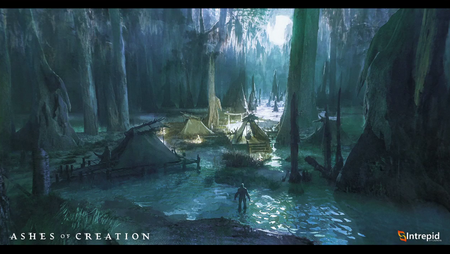
Part of the biome that the Ren'Kai are accustomed to is a more swamp or marsh oriented, so they have these almost stilt-like foundations on some of the assets because they're intended to sit above that marsh.[25] – Steven Sharif
Ashes of Creation will have a higher graphical fidelity than most western games. It will not be too stylized or "cartoony".[26]
- We can push the limits a little bit on the graphical fidelity, especially using Unreal Engine 4... My desire was not to see very cartoony games. I'm not a big fan of highly stylized art.[26] – Steven Sharif
- It's not to say that people can't do steampunk well. I've enjoyed some steampunk stuff. I'm a very high fantasy oriented type of storyteller; and the inspiration for Ashes obviously comes from my pathfinder campaigns that I ran long ago; and those are always set in a high fantasy world. So it just compromises what I believe is the perspective of the storytelling in the environment.[27] – Steven Sharif
- Estúdios intrépidos does not use AI for art production.[28]
- We do not use AI for production, except in unique internal cases when communicating fast reference material.[28] – Steven Sharif
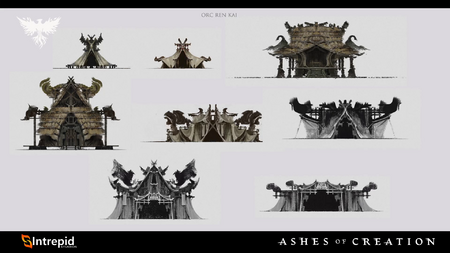
Character races are super important. These are the choices that we make at the onset of our adventure in an MMORPG: what race- not just mechanically aligns with our decisions, if those races have game mechanics behind them from a stat perspective, but visually and culturally and historically: What are these? What do these races represent? So it's important that visually they're distinct. And everyone's seen fantasy games do Elves, so everyone's seen them do Humans, everyone's seen them do Orcs: There's an established expectation almost behind what these traditional fantasy races represent; and there's a risk, because whenever you're creating a new IP or a new story or a new world- a new Universe; a realm in which things don't have to always be the norm, you can take a little bit of creative liberty to redefine some of the aspects of a particular race; and that can be a good thing, because it's something that is new to players. It's something that is unique to the realm that we're building- the surroundings that you have. So what we wanted to do was push a little bit more on the unique side of what the Py'rai would look like from a visual perspective.[30] – Steven Sharif
- Aelean architecture has a French medieval influence.[31]
- Dünir have a Nordic cultural influence.[32]
- Empyreans have a Greco-Roman imperialistic feeling.[33]
- The Kaelar have a European influence.[34]
- The Niküa have a Polynesian influence.[35][33]
- The Py'Rai have a Navajo Native American influence.[33] Py'Rai architecture has a woodland inspiration.[36][37]
- Pyrian architecture has a Greco-Roman influence.[38]
- Ren'Kai architecture has an Asian influence.[29]
- The Vaelune have a Middle Eastern influence.[39]
- The Vek have a Mesoamerican influence.[39]
- You will see in the different races that are available from a player character standpoint a lot of different influences that reflect many cultures in the world: Not just European, not just Africa, not Mesoamerican. These cultures are going to be present in many of the races.[40] – Steven Sharif
- The idea is just to find a base component in the real world as a starting point and then to begin to fantasize.[31] – Steven Sharif
Cultural references
There will be real-world cultural references, particularly with regards to real-world holidays and historical events.[41]
- These won't be out of place in terms of immersion. They will be homages.[41]
There will be some real world references, particularly with regards to potentially real world holidays as well as some historical events or cultures. For example the PAX East ship that was named Eleanor that we released a cosmetic of, you know, being a reference to the Eleanor ship that the tea was thrown off of; or colonialesque look.[42] – Steven Sharif
Open development
Estúdios intrépidos has embraced an open (transparent) development approach, rather than sharing information through carefully curated press releases and announcements.[43]
- Player feedback is important, but the developers will not change what they consider to be the core identity and vision for the game.[44][45][46][47][48]
- Player feedback is important, however the identity and the vision of the game is not up for discussion; and so when we talk about the core systems and tenets and philosophies behind what the game that we're trying to make is, we believe that the game we are trying to make resonates with a large enough section of the MMORPG player base that it is a sustainable and profitable venture for us to create that core game. Now, the ancillary systems that live around the core philosophy of Ashes of Creation, or the subtleties and what we need to do in order to make a particular system or feature better... that we want to collect player feedback.[45] – Steven Sharif
- Some game aspects will be more polished than others before they are presented.[49]
- The delicate blend between a transparent development process, but also understanding that [the] majority of your player audience will not grasp, or will not take into context, what a work in progress looks like. So certain things we have to polish to the point where they're presentable; where they can be understood- again in its own context without my verbal support or Margaret's verbal support.[49] – Steven Sharif
- I think that we live in an age where it's easy to be transparent if you're not trying to hide something. The downside is if you're showing something that's not a completed or finished product, it is incumbent upon the viewer to understand that fact.[43] – Steven Sharif
- The purpose of transparent development is to enable participation and feedback from the community without the need to purchase access.[50]
- The whole purpose of our development process being transparent being open is that you don't have to buy a package actually to participate. You can be a voice from the community. You can observe people playing. You can give your experiences and feedback.[50] – Steven Sharif
- I don't answer to a board. I don't answer to a publisher. We answer to our players; and we try to be as transparent as possible with showing our progress; and showing it in a timely manner.[51] – Steven Sharif
- There are obviously going to be some aspects of the development that we will not reveal, like lore and some system mechanics in order not to spoil the game for release.[52] – Steven Sharif
Ver também
Referências
- ↑ A reactive world - Nodes.
- ↑ 2.0 2.1 2.2 MMOGames interview, January 2017
- ↑ 3.0 3.1

- ↑ 4.0 4.1 4.2 4.3 4.4 4.5 4.6 4.7 Entrevista, 2018-08-24 (8:35).
- ↑ 5.0 5.1 5.2 5.3 5.4 5.5 5.6
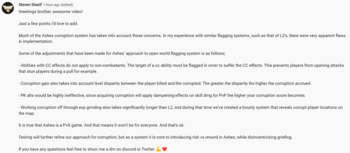
- ↑ 6.0 6.1 Entrevista, 2020-07-29 (9:02).
- ↑ 7.0 7.1 7.2 7.3

- ↑ 8.0 8.1 8.2 8.3 8.4
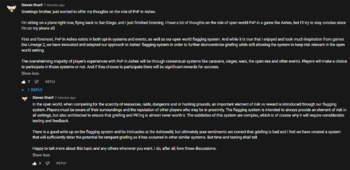
- ↑ 9.0 9.1

- ↑ 10.0 10.1 Entrevista, 2020-07-18 (41:54).
- ↑

- ↑ 12.0 12.1
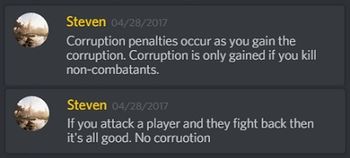
- ↑ 13.0 13.1 13.2 13.3 13.4 Transmissão ao vivo, 2022-10-28 (26:48).
- ↑ Transmissão ao vivo, 2022-10-28 (24:28).
- ↑ Entrevista, 2018-05-11 (5:05).
- ↑ Podcast, 2018-04-23 (51:31).
- ↑ Transmissão ao vivo, 2017-05-22 (42:33).
- ↑ Podcast, 2017-05-05 (43:05).
- ↑ Entrevista, 2020-07-18 (44:35).
- ↑ 20.0 20.1 Entrevista, 2017-04-27 (0:17).
- ↑

- ↑ Entrevista, 2019-04-22 (54:40).
- ↑ Transmissão ao vivo, 2017-11-17 (29:45).
- ↑

- ↑ 25.0 25.1 Transmissão ao vivo, 2022-02-25 (46:17).
- ↑ 26.0 26.1 Entrevista, 2018-10-20 (2:17:43).
- ↑ 27.0 27.1 Transmissão ao vivo, 2023-03-31 (1:17:42).
- ↑ 28.0 28.1

- ↑ 29.0 29.1 Transmissão ao vivo, 2019-10-31 (40:27).
- ↑ Transmissão ao vivo, 2022-02-25 (49:42).
- ↑ 31.0 31.1 Entrevista, 2018-10-20 (3:47:17).
- ↑

- ↑ 33.0 33.1 33.2 Entrevista, 2018-05-11 (1:03:21).
- ↑ Podcast, 2018-05-11 (31:35).
- ↑ Transmissão ao vivo, 2022-09-30 (1:08:24).
- ↑ Transmissão ao vivo, 2022-02-25 (44:28).
- ↑

- ↑ Transmissão ao vivo, 2017-10-16 (15:58).
- ↑ 39.0 39.1 Podcast, 2018-05-11 (31:35).
- ↑ Entrevista, 2018-05-11 (1:04:27).
- ↑ 41.0 41.1 Podcast, 2018-05-11 (36:28).
- ↑ Podcast, 2018-05-11 (36:28).
- ↑ 43.0 43.1 A chat with Ashes of Creation's Steven Sharif, 2017-06-7.
- ↑ Transmissão ao vivo, 2023-07-28 (1:30:11).
- ↑ 45.0 45.1 Transmissão ao vivo, 2023-04-07 (55:22).
- ↑ Transmissão ao vivo, 2023-03-31 (1:00:16).
- ↑ Transmissão ao vivo, 2022-10-28 (32:52).
- ↑ Transmissão ao vivo, 2017-06-01 (37:39).
- ↑ 49.0 49.1 Transmissão ao vivo, 2022-04-29 (21:00).
- ↑ 50.0 50.1 Transmissão ao vivo, 2021-12-23 (1:23:41).
- ↑ Entrevista, 2018-10-20 (3:43:52).
- ↑ 52.0 52.1

- ↑ Transmissão ao vivo, 2018-05-04 (39:41).